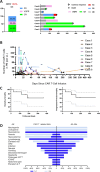BCMA/GPRC5D bispecific CAR T-cell therapy for relapsed/refractory multiple myeloma with extramedullary disease: a single-center, single-arm, phase 1 trial
- PMID: 40383818
- PMCID: PMC12087025
- DOI: 10.1186/s13045-025-01713-2
BCMA/GPRC5D bispecific CAR T-cell therapy for relapsed/refractory multiple myeloma with extramedullary disease: a single-center, single-arm, phase 1 trial
Erratum in
-
Correction: BCMA/GPRC5D bispecific CAR T-cell therapy for relapsed/refractory multiple myeloma with extramedullary disease: a single-center, single-arm, phase 1 trial.J Hematol Oncol. 2025 Jun 3;18(1):60. doi: 10.1186/s13045-025-01714-1. J Hematol Oncol. 2025. PMID: 40462189 Free PMC article. No abstract available.
Abstract
Relapsed/refractory multiple myeloma (RRMM) with extramedullary disease (EMD) represents a challenging condition, with limited treatment options and poor prognosis. We conducted a phase 1 clinical trial to evaluate the safety and effectiveness of a novel bispecific chimeric antigen receptor (CAR) T-cell therapy targeting two antigens, B-cell maturation antigen and G protein-coupled receptor class C group 5 member D (BCMA/GPRC5D), in this high-risk population. A total of 12 patients were enrolled, of whom 3 were excluded due to disease progression or death before CAR T-cell infusion, despite meeting the inclusion criteria, leaving 9 for analysis. The median follow-up was 6.08 months (Interquartile Range [IQR]: 0.9-16.5). All patients received BCMA/GPRC5D bispecific CAR T-cell therapy after bridging therapy with localized radiotherapy or Elranatamab. Efficacy assessments revealed that 100% of patients achieved partial response (PR) or better, with 44.4% achieving complete response (CR). Common adverse events included hematological toxicities such as anemia, leukopenia, and thrombocytopenia. Cytokine release syndrome (CRS) occurred in 66.7% of patients, all of which were grade 1-2, and no neurotoxicity (ICANS) was observed. The 1-year overall survival (OS) and progression-free survival (PFS) rates were 60% and 63%, respectively. Median OS and PFS were not reached. Collectively, these findings highlight a potential therapeutic strategy involving BCMA/GPRC5D dual-targeted CAR T-cell therapy for patients with aggressive forms of multiple myeloma, particularly those with extramedullary disease, and support the need for further exploration and validation in larger, multi-center clinical studies.
Keywords: BCMA; CAR T-cell therapy; Extramedullary disease; GPRC5D; Immunotherapy; Relapsed/refractory multiple myeloma.
© 2025. The Author(s).
Conflict of interest statement
Declarations. Ethics approval and consent to participate: This study was approved by the Ethics Committee of People's Liberation Army The General Hospital of Western Theater Command (Approval Number: 2024EC1-ky033). All experiments were conducted in compliance with relevant ethical guidelines and regulations. Consent for publication: Not applicable. Competing interests: Declaration of interests AHC is a founding member of Shanghai YaKe Biotechnology, a biotechnology company focusing on research and development of tumour cellular immunotherapy. All other authors declare no competing interests.
Figures

References
-
- Qi Y, Li H, Qi K, et al. Clinical outcomes and microenvironment profiling in relapsed/refractory multiple myeloma patients with extramedullary disease receiving anti-BCMA CAR T-cell-based therapy[J]. Am J Hematol. 2024;99(12):2286–95. - PubMed
-
- Gagelmann N, Riecken K, Wolschke C, et al. Development of CAR-T cell therapies for multiple myeloma[J]. Leukemia. 2020;34(9):2317–32. - PubMed
-
- Reyes KR, Huang CY, Lo M, et al. Safety and efficacy of BCMA CAR-T cell therapy in older patients with multiple myeloma[J]. Transplant Cell Ther. 2023;29(6):350–5. - PubMed
Publication types
MeSH terms
Substances
Grants and funding
- 2024NSFSC1292/Sichuan Provincial Science and Technology Support Program
- 2021YJ0145/Sichuan Provincial Science and Technology Support Program
- 2021-XZYG-B32/the general program of General Hospital of Western Theater Command
- 2021-XZYG-C45/the incubation program of General Hospital of Western Theater command
- 2021-XZYG-C46/the incubation program of General Hospital of Western Theater command
LinkOut - more resources
Full Text Sources
Medical
Research Materials

